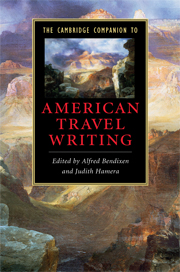Introduction: new worlds and old lands - the travel book and the construction of American identity
Published online by Cambridge University Press: 28 March 2009
Summary
“[W]hat would happen, I began to ask, if travel were untethered, seen as a complex and pervasive spectrum of human experiences? Practices of displacement might emerge as constitutive of cultural meanings rather than as their simple transfer or extension.” James Clifford / Travel and the construction of American identity are intimately linked. This connection undergirds commonplace descriptions of America as a nation of immigrants and a restless populace on the move. It lies at the heart of the politics of Manifest Destiny, in complex relationships between the technology, commerce, and aesthetics of the car culture, and in migration narratives from those of the Hopis and Zunis to those of the Beats. American travel writing both acknowledges this connection and deploys it to perform complex ideological and cultural work. It simultaneously exposes inter- and intra-cultural contradictions and contains them. It creates American “selves” and American landscapes through affirmation, exclusion, and negation of others, and interpellates readers into these selves and landscapes through specific rhetorical and genre conventions. Thus, after Clifford in the epigraph above, American travel writing, like travel itself, is constitutive, a tool of self- and national fashioning that constructs its object even as it describes it. The Cambridge Companion to American Travel Writing brings together thirteen new essays that explore the ways in which travel writing has defined, reflected, or constructed American identity. Although the travel book has always attracted a wide readership and the talents of major authors, it has only recently won significant attention from scholars.
- Type
- Chapter
- Information
- The Cambridge Companion to American Travel Writing , pp. 1 - 10Publisher: Cambridge University PressPrint publication year: 2009
- 7
- Cited by



